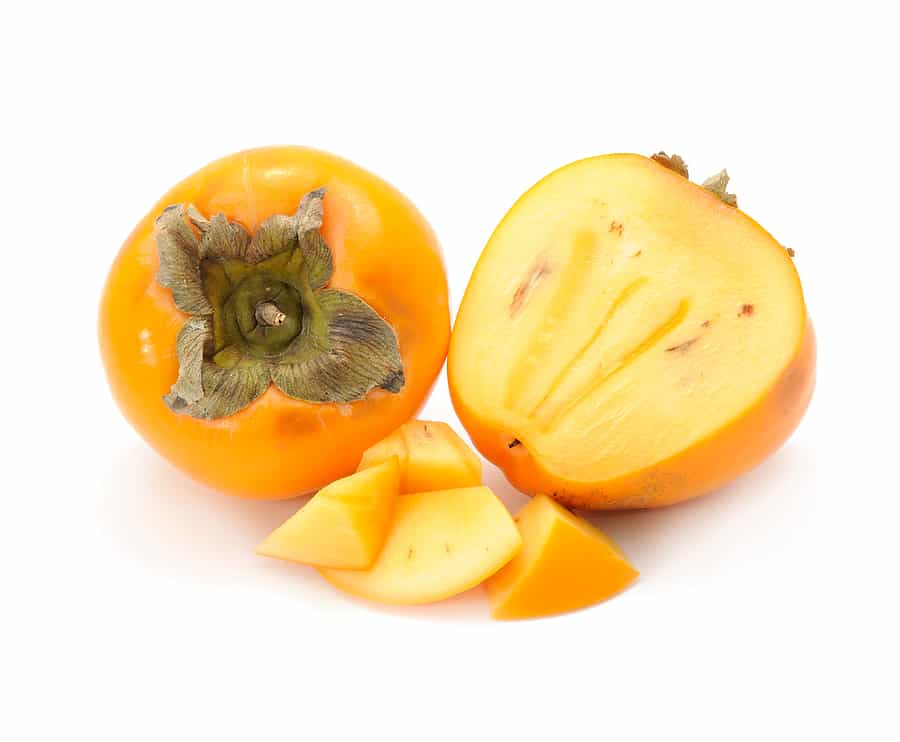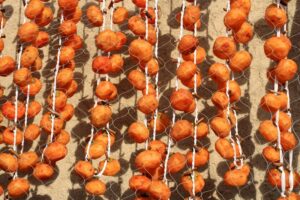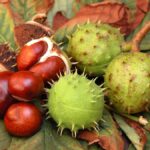Slice the persimmon down to the stem base once and then twice and lay it open like a flower. You can then enjoy its delightfully sweet and cool flesh spoonful by spoonful.
Some say the persimmon has a pumpkin flavor mixed with allspice and cinnamon. You will surely find it exotically sweet and very juicy.

A ripe persimmon can be enjoyed as a dinner starter or as a dessert. It can be eaten out of hand like an apple or puréed and used in baked goods, puddings, and all types of desserts.
Persimmons mature through the summer but are not ready for harvest until late fall. They reach their peak after all of the leaves on the persimmon tree have fallen. The first frost is said to heighten the persimmon’s sweetness.
Persimmon types and varieties
There are more than 50 common varieties of persimmons, but there are two that gather nearly all of the attention: the Fuyu and the Hachiya.
The Fuyu and Hachiya are known as Asian or Japanese persimmons. In Japan, China, and Korea they are called kaki fruit. Kaki fruit originated in China. Today the kaki is the national fruit of Japan and the traditional fruit of the Japanese New Year.
In the Western hemisphere, the word persimmon is used interchangeably to denote both the fruit native to North America and the fruit native to Asia.
American persimmons are preferred for preserves and cooking and are never eaten raw. Asian persimmons such as Fuyu and Hachiya are eaten raw or cooked and are usually dried in Asia.

The Fuyu has a sweet, mildly spicy flavor and can be eaten either firm or soft. The Fuyu is a squat almost squarish-shaped fruit. From a distance, it might be mistaken for a late-harvested tomato. The Fuyu’s flesh is reddish-yellow and it contains no tannins, an important point if you have ever bitten into the Hachiya which does contain tannins and can be quite astringent unripe.
A ripe Hachiya has a tangy-sweet flavor and will be pudding soft. It can not be eaten firm like the Fuyu. An unripe Hachiya will have yellowish-orange skin, be hard, highly astringent, and inedible. The Hachiya has an elongated heart shape of 4 or more inches long and 2½ to 3 inches across. It can commonly be half again larger than the Fuyu. The Hachiya has bright orange flesh and skin when ripe.
Persimmon harvest season
Persimmons are harvested from mid to late fall.
How to choose persimmons
Select persimmons that are plump and smooth with glossy bright color. The Hachiya is ripe and ready for eating when it is squishy-soft. The flat, tomato-shaped Fuyu is ready for eating when it is still firm. Choose persimmons that are bright orange or red. Persimmons mature from green to yellow to orange and red. Avoid persimmons with yellow patches.
Amount. One large persimmon yields ¾ to 1 cup of sliced fruit. One large soft persimmon yields ¾ to 1 cup purée.
Ripening persimmons
Unripe persimmons can be ripened at room temperature in a loosely closed paper bag. Ripening may take up to one week. Turn the persimmon occasionally as it ripens.
How to store persimmons
Ripe persimmons are best eaten immediately but can be refrigerated for 1 or 2 days. Unripe persimmons will keep in the refrigerator for up to one month. Keep refrigerated persimmons unwashed in a plastic bag.

How to freeze persimmons
Hachiya-type persimmons can be placed in a single layer on a baking sheet and frozen until solid. Then store them in freezer bags.
Persimmon purée can be frozen for up to 6 months. Stir 1½ teaspoon lemon juice into each cup of purée before freezing. Thaw at room temperature for 20 minutes.
How to dry persimmons
Persimmons can be dried and eaten like figs or dates. Set persimmon slices on a tray and allow them to dry in a cool, shaded spot for two weeks.
How to prepare persimmons
Prepare. Wash persimmons gently before eating. Core and discard seeds.
Cooking persimmons
Crisp, unpeeled persimmons can be used in cooking like apples. Purée softer persimmons for use in baking.
- Sautéing. Cut Fuyu-type persimmons into ½-inch wedges, discard the seeds, and sauté until hot and tender (3 to 5 minutes).
Serving persimmons
Asian persimmons can be eaten raw or cooked like an apple.
- Cut the fruit in half and scoop out the flesh with a spoon like a melon.
- Slice or dice the firm Fuyu and serve in winter salads or compotes.
- Eat the Fuyu out of hand like an apple.
- Use the Hachiya puréed as a topping for sorbets, ice cream, yogurts, custards, steamed pudding, cookies, cakes, quick bread, and crêpes.
- Serve persimmons slices with rice, fish and seafood, poultry, or smoked meat salads.
- Soft persimmon can be served with cream or milk.
- Serve Fuyu persimmons spears with cheese or smoked meats.
- Drizzle persimmon slices with orange-flavored liqueur.
- Add mashed Hachiyas to pancake or waffle batter.
Persimmon flavor partners
Persimmons have a flavor affinity for almonds, apple, brandy, cinnamon, ginger, grapes, hazelnuts, ice cream, kiwi, lemon, lime, orange, pine nuts, pomegranate, soft cheese, walnuts, and yogurt.
Persimmon nutrition
Persimmons are a good source of vitamin A and contain potassium, vitamin C, and copper. One medium-size raw persimmon will contain about 118 calories.
About persimmons
Persimmon trees can grow as tall as 50 feet but most grow much smaller, usually to 15 feet. The persimmon’s oval, glossy dark green leaves turn a rich golden-yellow color in the fall. The entire persimmon fruit is edible except for the seeds and the four papery leaves or calyx at the stem end of the fruit.
The word persimmon is derived from the Algonquin Native American word for “a dry fruit”. Persimmons native to North America—those known to the Algonquin people–grow to about the size of a large plum, less than half the size of most small Asian persimmons.
The botanical name of the Japanese persimmon is Diospyros kaki. The botanical name of the American persimmon is Diospyros virginiana.
The Latin genus name for the persimmon is diospyros which means “food of the gods”.
Also of interest:
How to Plant, Grow, Prune, and Harvest Persimmons
Articles of interest:
Best Herbs for Container Growing
Garden Planning Books at Amazon:
- Vegetable Garden Almanac & Planner
- Kitchen Garden Grower’s Guide Vegetable Encyclopedia
- Vegetable Garden Grower’s Guide
- Tomato Grower’s Answer Book
More kitchen tips:
Bring your harvest to the table. Kitchen prep tips and easy recipes for the vegetables you grow. Click below for vegetable prep and recipes you can use now.
- Almonds
- Apples
- Apricot
- Aprium
- Artichoke
- Arugula
- Asparagus
- Avocado
- Bamboo Shoots
- Banana
- Basil
- Beans, Dried
- Beans. Long
- Beans, Shell
- Beans, Snap
- Beets
- Bitter Melon
- Blackberry
- Bok Choy
- Broccoli
- Broccoli Raab
- Brussels Sprouts
- Cabbage
- Cardoon
- Carrots
- Cauliflower
- Celeriac
- Celery
- Chard
- Chayote Squash
- Cherimoya
- Cherries
- Chestnut
- Chickpea
- Chinese Cabbage
- Chives
- Cilantro
- Citron
- Clementine
- Collards
- Coriander
- Corn, Sweet
- Corn, Baby
- Corn Salad, Mache
- Cranberry
- Cress
- Cucumber
- Daikon
- Dandelion
- Dill
- Eggplant
- Endive, Belgian
- Endive and Escarole
- Fava Beans
- Fig
- Florence Fennel
- Garlic
- Ginger
- Grapefruit
- Grapes
- Guava
- Horseradish
- Jerusalem Artichoke
- Jicama
- Jujube
- Kale
- Kiwifruit
- Kohlrabi
- Kumquat
- Leeks
- Lemongrass
- Lemons
- Lettuce
- Lime
- Mache (Corn Salad)
- Mandarin Orange
- Mango
- Maple Syrup
- Marjoram
- Melons
- Michihili
- Mint
- Mizuna
- Mushrooms
- Mushrooms, Cremini
- Mustard Greens
- Napa Cabbage
- Nectarine
- Okra
- Olives
- Olive oil
- Onions
- Oranges
- Oregano
- Parsley
- Parsley Root
- Parsnips
- Passion Fruit
- Pawpaw
- Peaches
- Pears
- Peas, Garden Snap
- Peas, Snow
- Pei Tsai
- Peppers, Chili
- Peppers, Sweet
- Persimmon
- Pineapple
- Pineapple Guava
- Plantain
- Plums
- Pluots
- Pomegranate
- Potatoes
- Prickly Pear
- Pumpkin
- Quince
- Radicchio
- Radishes
- Raspberries
- Rosemary
- Rhubarb
- Rutabaga
- Sage
- Salsify
- Sauerkraut
- Savory
- Shallots
- Sorrel
- Spinach
- Squash, Summer
- Squash, Winter
- Strawberries
- Sunchokes
- Sunflower
- Sweet Potato
- Swiss Chard
- Tangerine
- Taro
- Tarragon
- Thyme
- Tomatillo
- Tomato
- Turnip
- Turnip Greens
- Yams















